#ca. 1st to 3rd century CE
Text
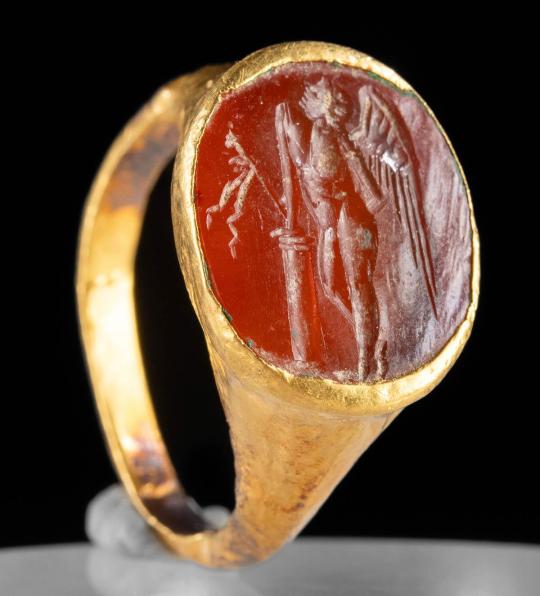
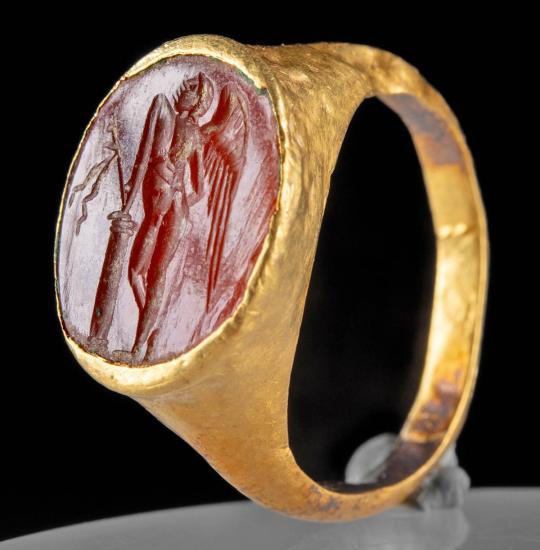
Roman Gold Ring w/ Carnelian Intaglio, Leaning Cupid
Imperial period, ca. 1st to 3rd century CE
#Roman Gold Ring#Imperial period#ca. 1st to 3rd century CE#gold#gold jewelry#ancient jewelry#ancient artifacts#archeology#archeolgst#history#history news#ancient history#ancient culture#ancient civilizations#ancient rome#roman history#roman empire#roman art
644 notes
·
View notes
Photo

Fragment of a limestone throne (?) with the head of a horned lion. ca. 1st–3rd century CE. Credit line: The Cesnola Collection, Purchased by subscription, 1874–76 https://www.metmuseum.org/art/collection/search/242189
#aesthetic#art#abstract art#art museum#art history#The Metropolitan Museum of Art#museum#museum photography#museum aesthetic#dark academia
58 notes
·
View notes
Text
Pagan/Occult timeline on this Tumblr
(with some accents on Frisia/Holland/the Netherlands)
Stone Age
Palaeolithic
. Rock art
Mesolithic
. Swifterbant Culture (in the NL ca. 5300-3400 BCE)
Neolithic
. Vlaardinger Cultuur (in the NL ca. 3500-2500 BCE)
. Trechterbekervolk (= Funnel Beaker Culture, in the NL ca. 3350-2750 BCE ) and their Hunebed (dolmen)
Ancestor worship may have existed in the Neolithic.
Some scholars suggest a direct link between Palaeolithic female ('venus') figurines and female depictions in the Neolithic and even Bronze Age. In the Copper Age, male deities were also worshipped, and there was a development towards forming a complete pantheon with mythological figures.
Domestication of plants and animals is in its formative stages here, and 'Industry' comes up, mainly of utensils and ornaments.
The invention of writing started here, between copper and bronze age. Invention of the wheel. Invention of the potter's wheel.
Bronze Age
Hallstatt Culture (roughly 1200-450 BCE)
Northern Bronze age (roughly 2000-500 BCE)
2000 BCE
17th century BCE
15th century BCE
13th century BCE
11th century BCE
10th century BCE
8th century BCE
. Oldest findings of Frisian pottery
7th century BCE
6th century BCE
Northern Iron age (roughly 500 BCE - 800 CE)
5th century BCE
4th century BCE
3rd century BCE
2nd century BCE
1st century BCE
1st century
. Oldest known runic inscription
2nd century
3rd century
4th century
. Big migration of North German and Danish tribes into East and Central (=North of the NL) Frisia, and expansion of West Frisia
5th century
. Oldest known runic inscription mentioning Oðinn
. Big migration of North German and Danish tribes into East and Central Frisia and expansion of West Frisia
. Rise of the Merovingian dynasty among the Franks
6th century
. Frisia is at its peak and now covers the Dutch entire North + West coastal region, river area, and North coast of Germany
. Merovingian dynasty at the Franks - expansion
7th century
. Transition younger futhark.
. Merovingian dynasty at the Franks - expansion
8th century
. Transition younger futhark
. Merovingians (Franks) incorporate Frisia. Put a lot of effort into converting forcing the local tribes in Europe to Christianity
Viking age (roughly 800-1100 CE)
9th century
. In now Frankish 'Frisia', the name Holtland appears
10th century
. Estimated writing of the Vǫluspǫ́.
11th century
12th century
. Floris II no longer calls himself Frisian, but Count of Holland
. Earliest known Western heraldic
The last bits of the Medieval age
13th century
. Estimated start of development of Christian "Kabbalah"
14th century
15th century
. Giovanni Pico della Mirandola (humanist, Hebrew studies)
. Johann Reuchlin (humanist, Hebrew studies, developer of the angel names)
. Heinrich Cornelius Agrippa (occultist, developer of the demon-scales)
Modern History
16th century
. Giordano Bruno
. Edward Kelley (also known as Edward Talbot)
. John Dee (occultist, developer of Enochian magic)
. Sir Francis Drake's drum
17th century
. Dutch Streekdracht Folklore estimated start
Athanasius Kircher (developer of the Tree of Life as used in Hermetic Kabbalah)
. Rosicrucianism
. The Lesser Key of Solomon
18th century
Dutch Streekdracht Folklore peaks
19th century
Dutch Streekdracht Folklore peaks
. Éliphas Lévi, real name Alphonse Louis Constant (occultist, writer of Dogme et Rituel de la Haute Magie and initiator of the Kabbalistic Cross)
. Helena Blavatsky (occultist, founder of the Theosophical Society and famous for her Atlantis work)
. Samuel MacGregor Mathers & William Westcott (founders of the Hermetic Order of the Golden Dawn)
. Arthur Edward Waite (occultist, GD member, laid down the foundations for nearly all contemporary tarot decks)
20th/21st century
Dutch Streekdracht Folklore decline
. Dion Fortune (occultist)
. Israel Regardie (occultist)
. Gerald Gardner (founder of Gardnerian Wicca)
. Doreen Valiente (co-founder of Gardnerian Wicca)
. Gareth Knight (occultist)
. Walter Ernest Butler (occultist)
. Dolores Ashcroft-Nowicki (occultist)
. Alex Sanders (founder of Alexandrian Wicca)
. Diana L. Paxson (Witch, Wicca, Asatru)
. Marian Green (Solitary Witch)
. Vivianne Crowley (Wicca)
. Frigga Asraaf (NL Asatru)
. Linda Wormhoudt (NL Shaman)
2 notes
·
View notes
Photo
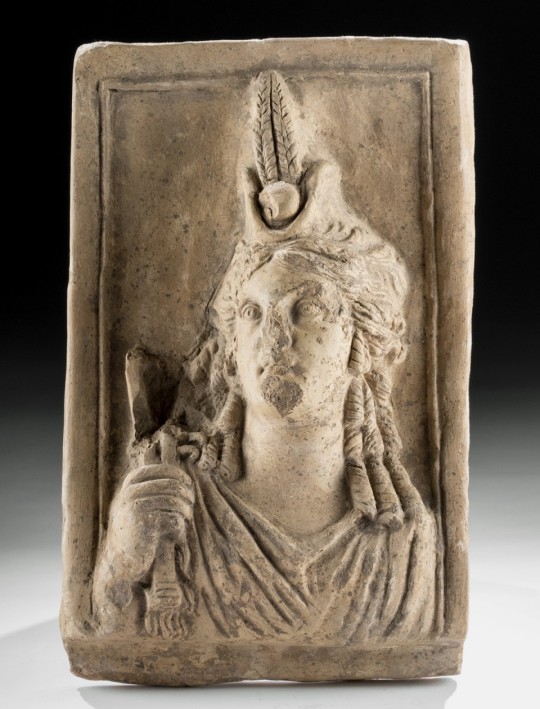
Isis, terracotta relief.
Roman, Imperial Period, probably from Egypt / Romano-Egyptian, ca. 1st to 3rd century CE
172 notes
·
View notes
Text
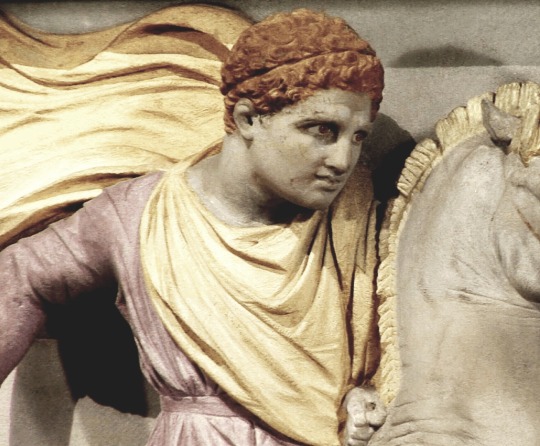
Alexander hunting lions on the marble Alexander Sarcophagus, 4th century BC.
From the Royal Necropolis of Sidon.
His hair, lips and eye contours were in red brown. His head has indentations for attaching a royal diadem.
-Istanbul Archaeological Museum.

A Graeco-Egyptian marble portrait head of Alexander The Great.
Mid-3rd/Mid-2nd Century BC.
The youthful head with short wavy fringe and long loose curls falling down over the nape of his neck, the sockets of his eyes deeply cut originally to have taken inlays, with sensitively modelled 'rings of Venus' on his neck, traces of brown painted gesso on some of the curls, mounted.
The head was believed to have come from Hermopolis (the city of Hermes), modern day Ashmunein.
-Formerly in the Maurice Nahman collection.

Limestone head of Alexander the Great.
Hellenistic period, 250-200 BC.
-Nicosia, Archaeological Museum, Cyprus.

Statue of the Dioskouroi with portrait head of Alexander the Great.
1st century AD. Found at Cyrene (Libya), Baths of Trajan.
-Cyrene Archaeological Museum, Libya.

The heroic courage, the "lion-like" of Alexander, was expressed in his portraits according to the ancient imagery by the strands thrown up over his forehead.
Ca. 270-246 BC from Alexandria.
-Landesmuseum Württemberg, Stuttgart.

Marble statuette of Alexander the Great as the god Pan.
From Pella, Macedonia. Around 300-270 BC.
The figure has two small horns projecting from the top of the head, pointed ears and a goat's tail, in imitation of the rustic half-goat deity Pan, who was popular in Macedonia. It is presumed that the statuette had cloven hooves which are now missing.
-Pella Archeological Museum.

A Hellenistic parian marble portrait head of Alexander The Great. Mid 2nd Century BC.
With luxuriant wavy hair, cupid bow lips and unarticulated eyes, head inclined slightly to left, a hole for fixing a diadem in the top of his head, traces of red on eyes and mouth and remains of gilding, mounted.
-Rheinischen Landesmuseum, Bonn.
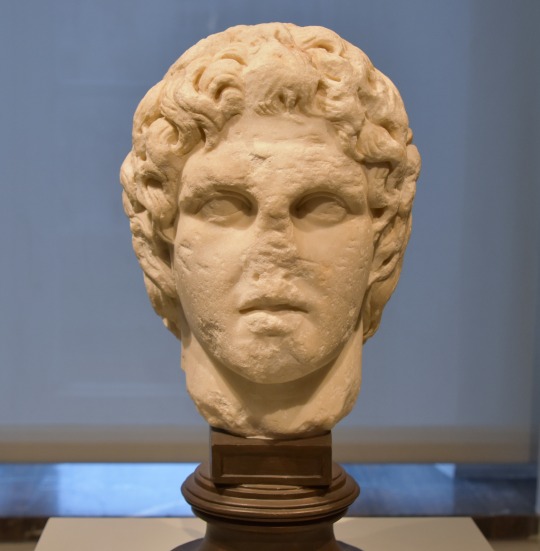
Head of Alexander of the "Erbach type".
The type is named after the best copy, found at Hadrian's Villa, Tivoli, now in Schloss Erbach, Germany. Also known as the "Acropolis-Erbach type" due to the similarity to the head from the Athens Acropolis.
Roman period copy of an original from around 330 BC. Acquired in 1874 in Madytos, Thrace.
-Altes Museum, Berlin.

A Roman replica of a marble head of Alexander the Great. It was found in Kom El Dekka in Alexandria by the Polish expedition. 31 BCE-395 CE.
The head bears the traditional features of the portraits of Alexander the Great which were mooraged by the sculptor Lysippos. The head is inclined to the right, the eyes are gazing meditatively into the distant horizon.
-Antiquities Museum, Bibliotheca Alexandrina.
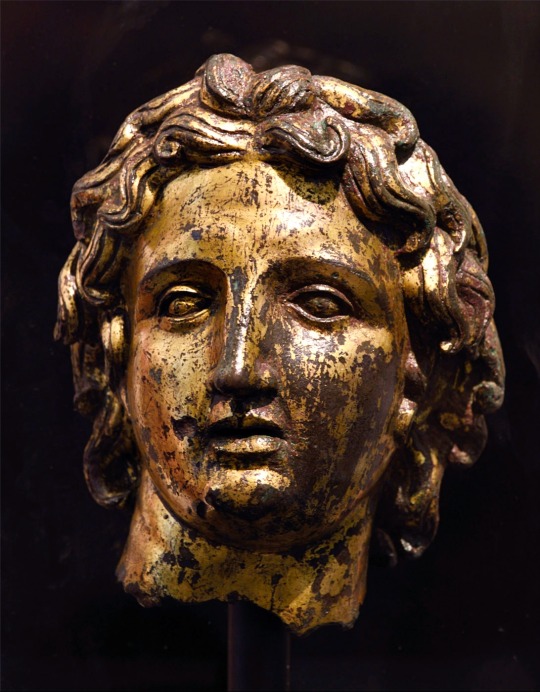
Gilded bronze head of Alexander the Great. 2nd century AD.
-Palazzo Massimo alle Terme, Roman National Museum.
7 notes
·
View notes
Photo
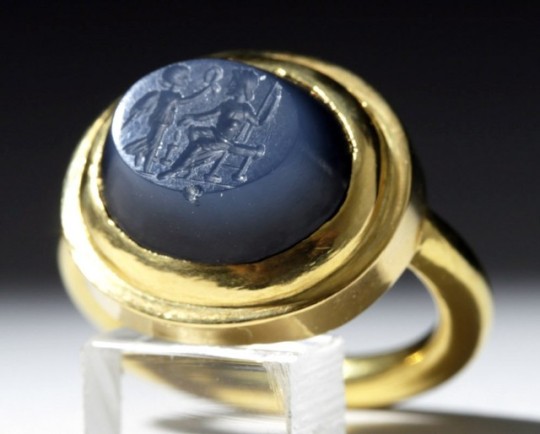
Ancient Roman Stone Intaglio. Roman Empire, ca. 1st to 3rd century CE.
From Artemis Gallery
Gorgeous blue agate incised with a scene of Victory presenting a wreath to a seated god or emperor.
236 notes
·
View notes
Text
Hyperallergic: Tribute to Palmyra Is the Getty’s First-Ever Online Exhibition
Johann Sebastian Müller after Giovanni Battista Borra, “Temple of Bel,” from Robert Wood’s ‘The ruins of Palmyra, otherwise Tedmor, in the desart’ (1753) (all images courtesy The Getty Research Institute)
Satellite images, cellphone images, and video footage spliced together by members of ISIS — these are the familiar visuals we see that emerge out of a war-torn Palmyra today. They record how much its landscape has changed only in the past two years as militants have destroyed much of the city’s ruins, erasing what stood for centuries. But Palmyra’s visual record extends far, far back, and it is through early drawings, prints, and photographs now made available online that we may better understand its history, which often risks getting lost in present-day discourse focused not only on warfare but also on “saving” cultural heritage.
Pierre Nicolas Ransonnette after Louis-François Cassas, “Temple of Baalshamin, plan and reconstruction,” from ‘Voyage pittoresque de la Syrie, de la Phoénicie, de la Palestine, et de la Basse Egypte’
This archive resides on The Legacy of Ancient Palmyra, an online exhibition the Getty Research Institute (GRI) launched this week as a tribute to the legendary caravan city. Intended as both a reference and teaching tool for the public, it is divided into sections that relay the history of Palmyra, from its status as a prominent cosmopolitan center of trade during the 1st and 3rd centuries CE to its present-day period threatened by violent destruction. Much of the historic imagery arrives from GRI’s own collections, including the earliest known photographs of Palmyra captured in 1864 by French naval officer Louis Vignes. GRI acquired these rare albumen prints in 2015, the year ISIS seized the city and quickly moved to obliterate its structures, viewing them as blasphemous.
You may read about the histories of Palmyra’s monuments on an interactive city plan, where Vignes’ photographs are accompanied by Victorian-era architectural plans and etchings of imagined reconstructions. Sites include the Temple of Baalshamin, the Temple of Bel, the Monumental Arch, and the Tetrapylon — each destroyed by ISIS, respectively, in August 2015, September 2015, October 2015, and January of this year.
Louis Vignes, “Monumental Arch” (1864)
Louis Vignes, “Temple of Bel” (1864)
Vignes photographs are, of course, the most definitively accurate representations of a historic Palmyra, but other illustrations in the exhibition offer a glimpse of how the city may have looked — and how it was perceived by the artists and explorers who passed through it after its “rediscovery” by the West in the late 17th-century. After English traders in Aleppo undertook an expedition in 1691, Western scholars and travelers began arriving to see the wondrous metropolis and its Greco-Roman architecture with their own eyes. GRI’s archives contains many etchings of the ruins and of specific decorative details; many of these are rendered after the works of Louis-François Cassas, who arrived to Palmyra in 1785 and left with detailed notes recording his observations. He made over 100 large-format etchings of the site and produced an expensive but popular three-volume book. They are important documents to study, having gone on to strongly influence the architectural and decorative styles of Western Europe — they remind of how the legacy of Palmyra survives even in our built environment.
“Pairing the Vignes photographs with our existing 18th-century etchings of Palmyra — made after drawings by Louis François Cassas — made evident that an exhibition highlighting these collections would tell a new story and bring a deeper understanding of this site featured in the headlines,” curator Frances Terpak told Hyperallergic.
Anonymous artist after Louis-François Cassas, “Temple of Bel, cella ceiling detail” (ca. 1799)
M. A. Benoist after Louis-François Cassas, “Temple of Bel, cella entrance detail,” from ‘Voyage pittoresque de la Syrie, de la Phoénicie, de la Palestine, et de la Basse Egypte’ (ca. 1799)
Notably, many of these explorers’ intentions resonate with a lot of the conversations concerning Palmyra today happening in the West. For antiquarians Robert Wood and James Dawkins, their 1753 text, The ruins of Palmyra, otherwise Tedmor, in the desart emerged from a desire to “rescue from oblivion the magnificence of Palmyra.” We see the same desire arising today from institutions and startups bent on developing the latest technologies to reconstruct ruins in the name of cultural preservation. While artists previously created paintings, drawings, and pristine architectural models that were displayed in lavish homes in Europe, our fetishization today arrives in the form of 3D digital models based on drone surveys and slick, 3D-printed reconstructions sent on world tours.
In this rising sea of digital archaeology, GRI’s archive is particularly significant and valuable because it doesn’t attempt to reconstruct what’s lost but rather highlights a history of which we seem to be losing sight or awareness. The Legacy of Ancient Palmyra is its first online exhibition; able to reach a global audience and filled with links to additional online resources, it strives for easy and open accessibility. Aside from simply sharing the link, you may download most images on the website to use as teaching tools, and even adapt or repurpose them through a Creative Commons Attribution 4.0 International License (CC-BY). GRI is also currently translating and redesigning the presentation for an Arabic-speaking audience. And as the institute develops the project, it may include “‘loan objects’ that expanded the narrative and more fully contextualized the prints and photographs,” as Terpak said.
With Palmyra frequently popping up in our news headlines, education on its history is crucial. The artists who created these works did so out of wonder rather than urgency, and their handiwork, which is irreplaceable, connects us to a distant era, perhaps more deeply than any digitally constructed form could.
Louis Perrier after Louis-François Cassas, “City plan of Palmyra,” from ‘Voyage pittoresque de la Syrie, de la Phoénicie, de la Palestine, et de la Basse Egypte’ (ca. 1799)
Photoengraving made by Charles Nègre from Louis Vignes’s photograph of the so-called Treasury at Petra, from Honoré Paul Joseph d’Albert, duc de Luynes’ ‘Voyage d’exploration à la mer Morte, à Petra, et sur la rive gauche du Jourdain (1874)
Louis Vignes, “Temple of Baalshamin” (1864)
Alexandre Moisy after Louis- François Cassas, “Tower tomb, cross section showing portrait busts,” from ‘Voyage pittoresque de la Syrie, de la Phoénicie, de la Palestine, et de la Basse Egypte’ (ca. 1799)
Charles Nicolas Varin after Louis-François Cassas, “Plan of the Temple of Bel,” from ‘Voyage pittoresque de la Syrie, de la Phoénicie, de la Palestine, et de la Basse Egypte’ (ca. 1799)
Jean-Baptiste Réville and M. A. Benoist after Louis-François Cassas, “Architectural ornament from Palmyra tomb,” from ‘Voyage pittoresque de la Syrie, de la Phoénicie, de la Palestine, et de la Basse Egypte’ (ca. 1799)
George Malbeste and François-Denis Née after Louis-François Cassas, “Middle section of Colonnade Street,” from ‘Voyage pittoresque de la Syrie, de la Phoénicie, de la Palestine, et de la Basse Egypte’ (ca. 1799)
The post Tribute to Palmyra Is the Getty’s First-Ever Online Exhibition appeared first on Hyperallergic.
from Hyperallergic http://ift.tt/2lMkI6H
via IFTTT
0 notes
Photo
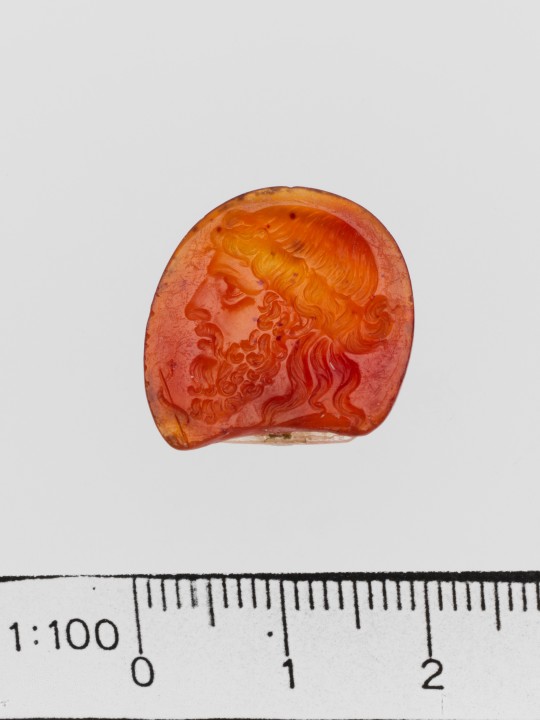
Carnelian ring stone. ca. 1st century BCE–3rd century CE. Credit line: Gift of John Taylor Johnston, 1881 https://www.metmuseum.org/art/collection/search/244964
#aesthetic#art#abstract art#art museum#art history#The Metropolitan Museum of Art#museum#museum photography#museum aesthetic#dark academia
9 notes
·
View notes
Text

Banded agate ring stone. Roman ca. 1st century BCE–3rd century CE. x
Ares.
The inscription lightly scratched in the field is not ancient.
27 notes
·
View notes
Photo

Carnelian ring stone. ca. 1st century BCE–3rd century CE. Credit line: Gift of John Taylor Johnston, 1881 https://www.metmuseum.org/art/collection/search/244989
#aesthetic#art#abstract art#art museum#art history#The Metropolitan Museum of Art#museum#museum photography#museum aesthetic#dark academia
4 notes
·
View notes
Photo

Red jasper ring stone. ca. 1st century BCE–3rd century CE. Credit line: Gift of John Taylor Johnston, 1881 https://www.metmuseum.org/art/collection/search/244966
#aesthetic#art#abstract art#art museum#art history#The Metropolitan Museum of Art#museum#museum photography#museum aesthetic#dark academia
2 notes
·
View notes